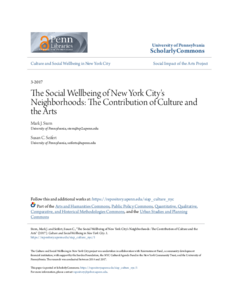
The social wellbeing tool enabled a variety of analyses: the distribution of opportunity across the City; identification of areas with concentrated advantage, concentrated disadvantage, and “diverse and struggling” neighborhoods with both strengths and challenges; and analysis of the relationship of “neighborhood cultural ecology” to other features of community wellbeing.
Major findings include:
- Cultural resources are unequally distributed across the city, with many neighborhoods having few resources.
- At the same time, there are a significant number of civic clusters—that is, lower-income neighborhoods with more cultural resources than their economic standing would lead us to predict.
- Although lower-income neighborhoods have relatively few resources, these neighborhoods demonstrate the strongest relationship between culture and social wellbeing.
Notably, if we control for socio-economic status and ethnic composition, the presence of cultural resources is significantly associated with improved outcomes around health, schooling, and personal security. Qualitative study highlighted how neighborhood cultural ecology also contributes to other dimensions of wellbeing—in particular, social connection, political and cultural voice, and the public environment and public sphere.
Source: Article Abstract
